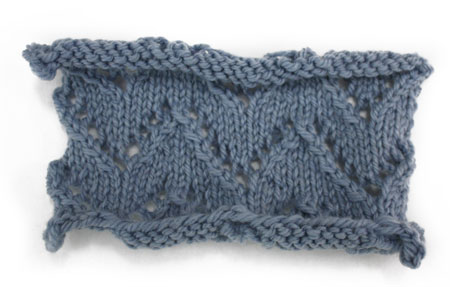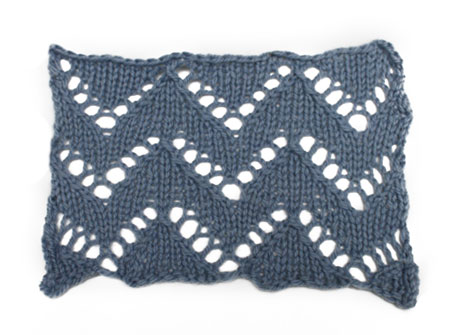There are so many great reasons to block your crocheting or knitting. However, a picture is worth a thousand words, so let me show you why you should consider blocking!

Here I did a swatch of simple chevron lace in Blue Bonnet Baby Wool. As you can see, there were quite a few problems with the swatch. First, the swatch was rolling, despite my best efforts to flatten it; this is because the lace pattern is based in stockinette stitch, which tends to roll. Second, the yarnovers for my lace are barely visible. Third, my stitches are a bit uneven; you can see that the ssks on the right side of the lace pattern are tighter than my k2togs on the left. Finally, I knew that this swatch wouldn’t give me an accurate gauge. Even if I didn’t block the garment I was swatching for, it will be worn and washed, which will change its gauge.

This is the same swatch after wet blocking. As you can see, the swatch is now flat with even, visible stitches. My gauge also changed considerably, going from five stitches per inch before blocking to four stitches per inch after blocking.
Want to learn more about blocking? Click here for more information on how to block.
Denise Amazonas
The recommendation to “block after knitting” should come in the pattern. Sometimes while knitting the piece you look at it and think you´re doing something wrong, when the truth is it will be gorgeous after blocking… ;o)
Docaye
Most of the fun of knitting for me is the way you turn a simple string into something gorgeous. Even that funny looking lace pattern you have been working on could be a work of art. Thanks for this.
Pctrainer_98
Does blocking work with only wool garments or will it work with other yarns?
Jacob Leatherberry
Blocking works for most yarns (wool, Alpaca,cashmere,llama,qivuit,dog, etc.) , except acrylic. However, you can “Kill” acrylic using steam. Cotton stretches when you wash it to almost 1/3 larger than the original size you knit it with.
Anonymous
In general, yarns made from animal fibers block very well. Plant fibers can also be easily blocked, but keep in mind that they tend to have less memory and, therefore, stretch a lot more (as Jacob mentioned below). Synthetics don’t respond well to regular blocking techniques, but you can “kill” your work to permanently block it. Here’s a tutorial on “killing” acrylic: http://rainyknits.blogspot.com/2006/08/blocking-acrylic.html I hope that helps!
Christineseip
I’ve heard that it’s pointless to block synthetics, as these yarns have good “memory”, and will spring back to their original dimensions as soon as they’re unpinned. Does anybody have any idea whether that’s true?
TychaBrahe
I crochet a lot in acrylic, because I make lap blankets for the VA hospitals. In a hospital you want something strong and washable. After I finish I machine wash the blanket and then dry it on a low heat. The heat changes the blanket, making is softer and more flexible. It’s like the difference between a sheet fresh out of the plastic wrapper that was ironed with sizing and a sheet after you launder it.
I usually wait until after laundering to weave in the ends, since the agitation and changes to the fabric will expose the ends anyway.
MaireZ
synthetics don’t block well – the fiber is pre-determined for stretch and memory when it is made. natural fibers will block fabulously, although you must be careful with cotton (see Jacob’s post).
Anonymous
It’s true that synthetics don’t usually respond well to wet or spray blocking. There is a technique for blocking synthetics — affectionately referred to as “killing” them — that will permanently change their shape. You can find a good tutorial on blocking synthetics here: http://rainyknits.blogspot.com/2006/08/blocking-acrylic.html
Blocking: Sebelum dan Selepas | AyzaStudyo.Com
[…] Untuk lebih lanjut, rujuk di sini http://blog.lionbrand.com/2011/03/07/blocking-before-after/ […]
Grace Elizabeths
Wow – this is quite a transformation. I used to never block because I didn’t understand why it was necessary but have become a believer.
Charcole98
After the blocking…does it stay this way? What would happen to it when it is washed?
Anonymous
The blocking does last. In general, I check out the shape and dimensions of my items after each wash/dry to see if they need blocked again. There’s no set amount that you need to block an item; just use your judgment and block when necessary. 🙂
Doneldah
I like the unblocked one better. Different tastes.
Mecmkk
I have blocked my acrylic granny squares before sewing them together to make them a more uniform size and easier to stitch together (for some reason different colors have slightly different weights). My mom came up with a great way to block them and I still use it. Take a styrofoam board, draw the size you want the squares to be. Pin the squares on the styrofoam with non rust pins and spray with water–damp not soaked. Allow to dry and remove. I usually use a large enough piece of styrofoam to allow me to block several squares at once. One group in the morning the other in the evening. Use the stryofoam that is dense not the craft stuff. I use the styrofoam that is used for insulation. After a while the holes from the pins will get too big and you will need to shift the lines or use the other side. I do them in batches as I finsh squares so when I have enough squares completed for the afghan, lap robe or throw they are ready to be stitched together. They wash well and retain their shape.
PBJ
I’ve made crocheted sachets and I’m wondering if I need to block the front and back pieces before I put them together. They were made with Size 10 cotton thread. TIA.
PBJ
I’ve made crocheted sachets and I’m wondering if I need to block the front and back pieces before I put them together. They were made with Size 10 cotton thread. TIA.
Anonymous
You don’t really need to block your sachets, as they won’t be laundered and don’t need to be a particular size. However, if you’d like to even out your stitches or stretch the sachet to a certain size, you can certainly try blocking them. Experiment to see if you like the technique with your project.
Humorme
I have found what I think is a perfect blocking tool. I use a cutting board – the kind you buy at a fabric shop that is about 4′ x 6′ and folds to 4′ x 1′. It is gridded to the inch, ensuring the perfect size, and is large enough for most of my projects except afghans. I cover it with enough waxed paper for the project I am blocking, and get busy! Pins go into it easily, it is durable, and portable. And the grid lines are a HUGE help in blocking to size or making sure the piece is squared up. And when the piece is dry, I just roll up the waxed paper for the next time.
Hazelrie
I also use this method. I make a lot of baby blankets in acrylic. I usually leave them on overnight after the spray method and works well for me.
jmack
I’ve been knitting a long time but rarely make sweaters. It seems, even though I have checked the guage – and it’s accurate – it’s all wrong when I seam the pieces together. I know about blocking but it always seems pointless when my finished piece looks nothing like it should. I will try blocking before piecing next time. But should I also block my test swatch?
Anonymous
Great question. I absolutely think you should block your gauge swatch as well as your finished item. Here’s my reasoning: your finished sweater will inevitably be laundered in some way. Blocking your swatch will show you how laundering will affect the garment. Blocking will also show you how your yarn will stretch and will help your stitches lay flat. Give it a try on a small item like a baby blanket or sweater to give it a try.
Christineseip
Blocking your test swatch is highly recommended. You will have a good idea of how your whole project will respond to blocking (a possible big change in gauge after blocking, for example). You can also see how the fabric will look after being knitted up with your chosen yarn and needles. Sometimes a project that sounds great in theory doesn’t translate well in practice. If you invest some time in a decent sized gauge swatch that’s been blocked, you may decide to make some changes, or bail entirely, without much time/money/tears involved lol.
Teresa
I’m here from Knit Purl Gurl’s blog and this post caught my eye. My mom crocheted an afghan for me many years ago and it was never blocked. I’m wondering if it is too late to do so now or if it would even really matter?
Docaye
Teresa, it really depends on the kind of yarn and the pattern it is. Is it lacy and something that would ‘open’ like the swatch above? If not, I’d probably leave well enough alone. I also think knitted things benefit from blocking more than crocheted things.
andi
Wonderful information!
I came here from KnitPurlGurl and am going to subscribe… hope to see more crochet on here! (LOVE your yarns, too.)
10 Tips for Washing Your Handmade Items | Lion Brand Notebook
[…] Blocking: Before & After […]